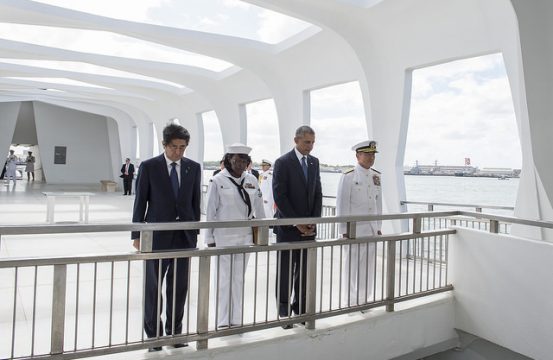 On the morning of December 27, 2016 local time, Japanese Prime Minister Shinzo Abe and U. S. President Barack Obama visited Pearl Harbor in Hawaii to pay their respects to those who lost their lives in the war. Afterwards, in a speech in front of ex-servicemen who survived the attack on Pearl Harbor, Abe vowed to renounce war, emphasizing the power of Japan-U. S. reconciliation, which has turned enemies into close allies.
On the morning of December 27, 2016 local time, Japanese Prime Minister Shinzo Abe and U. S. President Barack Obama visited Pearl Harbor in Hawaii to pay their respects to those who lost their lives in the war. Afterwards, in a speech in front of ex-servicemen who survived the attack on Pearl Harbor, Abe vowed to renounce war, emphasizing the power of Japan-U. S. reconciliation, which has turned enemies into close allies.
Taken together with Obama’s visit to Hiroshima in May, the visit to Pearl Harbor demonstrates the progress Japan and the U. S. have made with historical reconciliation. On the other hand, the visit once again highlighted the current stagnation in historical reconciliation in Asia. Commenting on Abe’s visit, China, Korea, and certain historians in the United States warned that Japan could not put its wartime past behind it without reconciling with Asia. China said that the visit to Pearl Harbor should have been preceded by a visit to the Nanjing Massacre Memorial Hall, and that Japan must face up to its past of aggressive warfare.
In the interests of historical reconciliation, Japan should continue to pay careful and sincere attention to calls for it to “face the past,” calls that are a constant refrain in the controversy over World War II. However, I would venture to emphasize that appealing for historical reconciliation is more than just a matter of facing up to the wars of the past.
Japan-U. S. reconciliation has been supported by “another past” that took place after World War II. According to a Pew Research Center survey published in April 2015, 31 percent of Americans gave World War II as an answer to the question “As you think about relations between the United States and Japan over the last 75 years, which one of these events is most important in your opinion,” but the same number also mentioned the Great East Japan earthquake in 2011.






